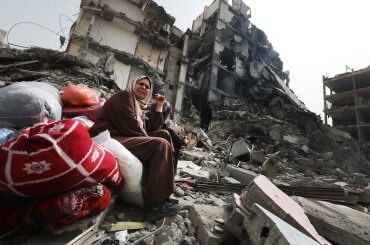Normal
0
false
false
false
MicrosoftInternetExplorer4
st1\:*{behavior:url(#ieooui) }
/* Style Definitions */
table.MsoNormalTable
{mso-style-name:”Table Normal”;
mso-tstyle-rowband-size:0;
mso-tstyle-colband-size:0;
mso-style-noshow:yes;
mso-style-parent:””;
mso-padding-alt:0in 5.4pt 0in 5.4pt;
mso-para-margin:0in;
mso-para-margin-bottom:.0001pt;
mso-pagination:widow-orphan;
font-size:10.0pt;
font-family:”Times New Roman”;
mso-ansi-language:#0400;
mso-fareast-language:#0400;
mso-bidi-language:#0400;}
My dearest Jewish friend, Ms. Lizzy Ratner,
It warmed my heart to hear that your six-day sojourn through Poland’s cities, towns and villages led you to discover the one-thousand-year old history of Polish Jewry and to feel a deep personal attachment to the land of your ancestors which you wrote about in your article “In the Beloved Old Country, a Jew has Visions of her Homeland”.
I have been returning to Poland the last few years, to the country of my birth, which my family fled from communist persecution. I too feel that deep, inner longing to rediscover and connect to the Jewish half of the Polish soul, or is it the Polish half of the Jewish soul?
When I visit Poland, I make sure to take in the weeklong Festival of Jewish Culture at the end of June held in the Jewish district of Krakow, capped by thousands upon thousands of Poles crammed into the Old Jewish Square swaying to the best Klezmer music from around the world. Once, when I was employed in Warsaw for a few months, I called-in sick in order to travel to the city of Lodz, to run my fingers across the marvelous red-orange brickwork of the old textile factory owned by the Jewish magnate Izrael Poznanski—the king of cotton. Then onto to his home, the stunning baroque Poznanski Palace, now housing a museum dedicated to the history of Lodz, which resonates in my mind because of a picture of a remarkably cosmopolitan choir in pre-war Poland composed of one third Catholic Poles, one third Jewish Poles, and a third Germans. I took pictures of myself sitting next to the famous pianist Arthur Rubinstein or, rather, the life-sized bronze statue of him playing the piano on Piotrkowska Street. Of course, merriment aside, I also made the obligatory pilgrimage to Auschwitz, as well as Stutthof and Majdanek, to pay my respects to the victims of the German Nazis.
As long as I can remember, I was fascinated by Polish Jewish culture—the good and the bad. I was an odd boy, in that most of my friends at the Catholic School I attended in Canada read marvel comics and hardy boy novels, while I read Elie Wiesel and letters from Auschwitz. My friends, all Detroit Tigers fans, followed Kirk Gibson and Alan Trammell religiously, and I did too, but I also followed Pope John Paul’s visits to Auschwitz where he knelt and prayed, his visit to the Great Synagogue in Rome, and watched through tears as he placed a prayer in the Wailing Wall in Israel.
The words he issued commemorating the 50th anniversary of the Warsaw Ghetto Uprising still echo in my heart, “As Christians and Jews, following the example of the faith of Abraham, we are called to be a blessing to the world. This is the common task awaiting us. It is therefore necessary for us, Christians and Jews, to be first a blessing to one another”.
What I am trying to say, is that as a Polish-Catholic raised in a conservative Polish-Catholic home, I was and remain in search of an honest conversation between Poles and Jews, and I have to admit it is disheartening to find time and again the lines of communication between these two storied peoples, sharing a beautiful and tragic one thousand year old history to become, so corroded by anger and beset by a sclerosis due to politics and campaigns of misinformation that perpetuate misunderstanding.
For all the positives contained in your article, Lizzy, I am crestfallen when I see that even an educated, curious, and sincere Jewish person such as yourself can write words like, “the Nazis (with later help from the Poles and the Communists), really did do a smash-up job of erasing a whole culture” and refer to a “pre-Nazi Poland” as if there ever was a Nazi Poland.
These words, essentially equating Poland with the German Nazis, or at the very least putting them on the same team, are printed a mere week after Poland commemorated the 65th Anniversary of the Warsaw Uprising in which the entire city rose up against the might of the German Nazi war machine and held up for 63 days armed with bricks, slingshots, Molotov cocktails and rudimentary guns. In the end, the British and the Americans and the French and Russians stood by and watched as 200,000 Poles were slaughtered and 90 per cent of the city razed to the ground. Imagine, Poles suffered the equivalent of a 9/11 for 63 straight days. Six million Poles, including three-million non-Jewish Poles, were killed at the hands of the German Nazis.
My dearest Lizzy, I wonder if the ethnocentric Jewish lenses you acknowledge you had been given “like most Jewish kids” allowed you to see the basic fact that Poland was the only country that fought against Nazi Germany from the very beginning of the Second World War until its conclusion? Were you aware Poland opposed the Soviet Union which invaded from the east and deported and murdered hundreds of thousands of its citizens in the very first months of the war?
I wonder if those same lenses have not kept you from seeing facts which we Poles consider basic, pre-school history, that the Polish underground resistance, called the Home Army, which organized the Warsaw Uprising, was the largest resistance movement in Europe, and that it even organized a group—Zegota—with the sole purpose of rescuing Jews, even though the price paid for being suspected of aiding a Jew in Poland was instant death for you, your family, and your neighbors.
On this note, it pains me in particular, that you equate Poles with Nazis and the Communists. Despite the penalty of immediate execution for any Pole suspected of assisting a Jew, a penalty imposed nowhere else in Europe, neither in gallant France, or the Netherlands, there are more Poles honored in Yad Vashem for rescuing Jews than any other nationality. And I suspect that the numbers at Yad Vashem are very conservative. Why? Because my grandmother, Wladzia, hid a Jewish family in her cellar for months, provided them with food and clothing, though she herself was dirt poor, risking the lives of her entire family. Wladzia, like many Poles, does not have a tree planted in her name at Yad Vashem and never will.
Brilliant filmmakers and students of the Holocaust like Steven Spielberg moved mountains to make us familiar with the name of Oskar Schindler, the German industrialist, who used his great wealth to rescue 1,200 Jews from extermination, and yet it took a group of some beautiful high school students in Uniontown, Kansas, to bring to our attention, sixty long years after the fact, Irena Sendler, a Polish-Catholic nurse, who saved 2,500 Jewish children from certain death with much, much fewer resources than Mr. Schindler and undertaking much greater risks. I dream of the talented Steven Spielberg capturing the story of her bravery as only he can do and wonder what’s the hold up?
I lived in Nashville for five years, where I studied at Vanderbilt University. My proudest achievement was being the co-chair of Vanderbilt’s 30th Annual Holocaust Lecture Series, the longest running such serious in the United States, which through its history has invited scores of thinkers and activists from around the world who study the Holocaust and other genocides. For a student of the Holocaust, it doesn’t get much better than sitting in on a lecture, and having dinner with, Pulitzer Prize winning historian Saul Friedlander.
And yet, as part of the Lecture Series, I remember taking a group of undergraduate and graduate students to the National Holocaust Memorial Museum in Washington, which was wonderful, except for two things. It seems even the Holocaust Memorial, dedicated I assume to an honest examination of the shoah, was handing out the same lenses that you, Lizzy are wearing.
Our tour guide, a truly lovely elderly Jewish woman, whisked us by the displays showing the execution of Poles and Polish priests at the hands of the German Nazis, while slowing down by the other ‘regular’ displays long enough to tell us that Poles were just as murderous of Jews as the Germans, and that the Nazis were Christian. I was numb.
At the end of our two hour tour through history, we gathered in a conference room to discuss what we had seen. A bright, young law student, not an undergraduate student mind you, but an advanced law student, raised his hand and said, “Okay, we know that Poles welcomed Hitler with open arms when he crossed into their country…. ”. I couldn’t let him finish. I raised my hand and politely corrected him in much the same way as I am correcting you. How is it possible for such a highly educated person to come away with such a horribly mistaken impression from the country’s most esteemed Holocaust institution? And what of the 30 million people who have visited the museum thus far?
Please allow me one final vignette from my search for an honest conversation between Poles and Jews.
Three years ago, as a member of Vanderbilt’s Holocaust Lecture Series, we invited a supremely talented Yiddish writer, a woman of immense charm, and a survivor of the Lodz Ghetto, to give a lecture. I remember striking up a conversation with another elderly Jewish woman in a wheelchair who was waiting outside to get into the packed auditorium.
She started telling me about her experiences in Lodz. I corrected her pronunciation and her eyes lit up. “You know Wooodge?” She said. I said I do, and she immediately started telling me about the bakery her family owned on Piotrkowska Street before the war, not too far from where the bronze statue of Arthur Rubinstein now sits. I asked her if she would ever go back. She gestured for me to lean in a little closer and whispered, ‘no, I wouldn’t. Never. Those Poles would kill us all”.
And here is the greatest irony. That evening, as the elderly Yiddish author concluded her lecture, she became faint, and collapsed on stage. Luckily, as the rest of the crowd looked on, stunned, frozen, one of the members of the Lecture Series, the wonderful Vanderbilt music professor Michael Rose, leaped up and braced her fall.
I joined him shortly thereafter, cradling the head of this old, Holocaust survivor in my hands, placing a damp cloth on her forehead, and gently caressing the silver hair away from her eyes.
I looked up at Professor Rose, with whom I had once discussed organizing a concert at Vanderbilt University to promote Christian, Jewish and Muslim understanding, in the great tradition of the annual Vatican concerts started by Pope John Paul II.
He looked at me, a Polish-Catholic cradling this fragile, Jewish soul, in my hands, a treasure, one of the few remaining witnesses of the Shoah.
As she regained her wits, she grasped my hand, looked up, smiled, and said, ‘my, you’re handsome’. She was fine.
My eyes welled up. I looked out into the crowd and passed the Jewish woman in the wheelchair, and passed another Jewish professor who once called me ‘the son of a perpetrator nation’.
I have spent my young life searching for an honest conversation between Jews and Poles.
Irek Kusmierczyk is a PhD Student, Political Science, Vanderbilt University

